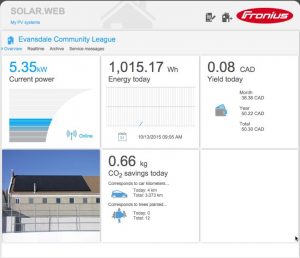By David Dodge & Dylan Thompson
In Edmonton, Alberta, almost every neighbourhood has a community league. These locally elected boards of community volunteers do the good work of running facilities and programs and engaging in civic issues. There are 158 such leagues in the city. It’s the most grassroots level of representation we have and these dedicated volunteers drive the community’s agenda.

Evansdale Community League enlisted the support of solar engineer Gordon Howell (left) the City of Edmonton (Councillor Ben Henderson (centre) to build it’s 13.6 kW solar system as an investment in community. Also pictured is Jeff Muiselaar, president of Evansdale Communtiy League in Edmonton. Photo David Dodge
My own community league runs soccer programs, an outdoor hockey rink and dance programs while also advocating for the neighbourhood on municipal issues and much, much more. Personally, I’ve volunteered in some capacity with them for the past 20 years. I’ve coached sports teams, been on the board as president and vice-president and been active in many civic issues and committees.
It’s safe to say that I’m a big believer in the importance of community leagues and in the contribution they make to the quality of our life. While the leaders of the world meet in Paris and craft sweeping policy that affects the entire planet, let’s remember that the most important changes usually happen close to home.
Since 2012, I’ve travelled all over Canada profiling inspirational and successful renewable energy projects. I’ve seen the positive things solar and energy efficiency can do for communities. So when we started a big infrastructure refurbishment project at Evansdale Community League, I knew exactly what to push for.
Part of a larger project
We raised $800,000 to repave the ball hockey and basketball courts, install a new outdoor hockey rink and build an accompanying winter sports facility. As part of that project we also installed super-efficient LED rink lights and two LED parking lot lights. The icing on the cake: we spent $43,500 installing a 13.6 kilowatt solar system.

Community leagues in Edmonton helped start hockey programs which are now run by hockey organizations, but true to its roots Evansdale Community League now has a shop full of skates, sticks and pucks that are loaned free to people in the community. Photo David Dodge
Gordon Howell is the electrical engineer who designed our system. By his calculations, this project will generate about half of the electricity we use over the course of a year.
“Over the longer term, it’s a phenomenal investment,” says Howell. Making the decision even easier was that the City of Edmonton and the government of Alberta covered 85 per cent of the upfront costs with an infrastructure grant. With that money our solar project has a simple payback of four to five years depending on the price of electricity.
The final cost of the system came in at $3.20 an installed watt, less than what people in California are paying for similar rooftop systems.
Solar, the only infrastructure that pays dividends
Don’t get me wrong, sports courts and ice rinks are all important threads in a community’s fabric, but they cost money to operate and require maintenance and replacement as they depreciate over time.

Evansdale Community League can check it’s solar energy production anytime by checking in with a web page that monitors solar production. Unfortunately this page can’t be shared publicly on the community group’s website. You can however see weekly and daily production: www.evansdale.ca/solar/
The LED lights and solar system are different. The lights will save 65 per cent on electricity costs for our rink and the solar system will pay a dividend every single month for the next quarter century.
“All the money that you save in the meantime [with solar], you can put towards community sports programs and the like,” says Howell.
Although it’s a small project, both the LEDs and solar system tie into the City of Edmonton’s community energy transition plan. We chatted with Edmonton Mayor Don Iveson about this ambitious plan. The city wants 10 per cent of Edmonton’s electricity locally generated from renewable sources by 2035. Community league roofs are a great place to start.
Ben Henderson is an Edmonton city councillor. He supported the energy transition plan and considers projects like this to be crucial to achieving those goals.
Finding the big picture
“Each of these [projects] feels like a small piece of the puzzle, but when you add them up, it’s the only way you actually get any real change,” says Henderson.
“Our energy transition strategy is about two things. It’s about how we can up our game and show leadership in terms of our own practice, but it’s also creating incentives that make it easier for businesses, for [community] leagues, for all sorts of non-profit groups, and for individuals on their own houses to be able to step up as well and take away some the real or imagined barriers that are stopping people from making those choices.”
Evansdale’s 13.6 kilowatt solar system will cover about half of our annual electricity use—but in case you didn’t notice, only half our roof is covered with solar. Gordon Howell designed the system so it’s easy for us to double its size in the future to fully cover our electricity needs.
While helping to manage such a big project may have greyed a few more of my hairs, it’s worth it every time I drive past the community league hall and see the sun shine on our future.


